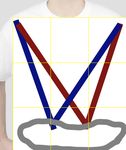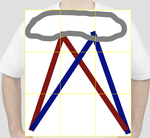D.A.(Tony)Stewart
Advanced Member level 7
- Joined
- Sep 26, 2007
- Messages
- 9,016
- Helped
- 1,824
- Reputation
- 3,647
- Reaction score
- 2,202
- Trophy points
- 1,413
- Location
- Richmond Hill, ON, Canada
- Activity points
- 59,604
Sorry your specs are inadequate to design a reliable solution due to reflectivity of object range, skew motion, room reflections etc. It would be complicate to focus ultrasound, or laser without scattering and invalid measurements.
So again I say why not keep it simple ... How 4 narrow beam ultrabright 5mm LEDs in a light guide tube. (5mm black heat shrink)
LED's Horizontally emitting just below shoulder height but separated and by 1 meter and each pair of crossing beams overlaps at the desired position your want from reference points.
If they move until the beams converge, it might look as below. I chose a pair of blue to aim at left should and a pair of red for the right shoulder. with a Red Blue pair separated by say 1 m so slightly less than 45deg cross beams.

aligned at right distance.

aligned but wrong distance

misaligned on left shoulder only

One arrangment of LEDs cast across shoulders intersecting on chest..
User has a mirror to aid in visual alignment.
Does that work for you? if not why not?
So again I say why not keep it simple ... How 4 narrow beam ultrabright 5mm LEDs in a light guide tube. (5mm black heat shrink)
LED's Horizontally emitting just below shoulder height but separated and by 1 meter and each pair of crossing beams overlaps at the desired position your want from reference points.
If they move until the beams converge, it might look as below. I chose a pair of blue to aim at left should and a pair of red for the right shoulder. with a Red Blue pair separated by say 1 m so slightly less than 45deg cross beams.

aligned at right distance.

aligned but wrong distance

misaligned on left shoulder only

One arrangment of LEDs cast across shoulders intersecting on chest..
User has a mirror to aid in visual alignment.
Does that work for you? if not why not?
Attachments
Last edited:
